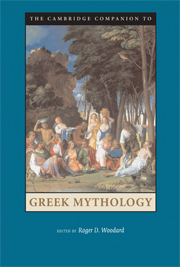Book contents
- Frontmatter
- Introduction: Muthoi in Continuity and Variation
- Part I Sources and Interpretations
- Part II Response, Integration, Representation
- Part III Reception
- 13 Women and Greek Myth
- 14 Let Us Make Gods in Our Image: Greek Myth in Medieval and Renaissance Literature
- 15 'Hail, Muse! Et Cetera'': Greek Myth in English and American Literature
- 16 Greek Myth on the Screen
- Bibliography
- Index
15 - 'Hail, Muse! Et Cetera'': Greek Myth in English and American Literature
from Part III - Reception
Published online by Cambridge University Press: 28 March 2009
- Frontmatter
- Introduction: Muthoi in Continuity and Variation
- Part I Sources and Interpretations
- Part II Response, Integration, Representation
- Part III Reception
- 13 Women and Greek Myth
- 14 Let Us Make Gods in Our Image: Greek Myth in Medieval and Renaissance Literature
- 15 'Hail, Muse! Et Cetera'': Greek Myth in English and American Literature
- 16 Greek Myth on the Screen
- Bibliography
- Index
Summary
In Keats’s 'Ode on a Grecian Urn' we are invited to view the urn from conflicting perspectives. From one angle it seems sterile and artificial, a 'cold pastoral' (45) depicting 'marble men and maidens overwrought' (42), but it can also be seen as a site of primitivism and passion, of 'wild ecstasy' (10). The narrator seems as unsure of his own feelings about the urn as he is about its nature, being in turn repulsed and frustrated by its chilly reticence - ’thou silent form, dost tease us out of thought' (44) - and attracted to its ancient beauty. The ambiguities inhere even within individual words and phrases. Are the 'overwrought' maidens panic-stricken (and thus real) or merely engraved? And do the famous last lines offer an answer to the poem’s problems or are they, as T. S. Eliot thought, 'meaningless'?
The Ode’s uncertainties mirror similar tensions and shifts, though on a larger scale, in the post-Renaissance reception of Greek myth more generally. It is possible to identify times when Greek myth has been a potent literary influence and others when it has been largely ignored by most major writers. But to characterise this period in terms of a stark debate between classicism and anticlassicism would not be accurate. Equally important have been the debates between classicists, between different versions or constructions of Greek myth. Many of the most interesting responses to Greek myth register its polyvalency and display a corresponding ambivalence towards their sources, a combination of reverence and antagonism. It has been thought to signal sterility or fertile invention, tradition-bound conformity or rebellious subversion.
- Type
- Chapter
- Information
- The Cambridge Companion to Greek Mythology , pp. 425 - 452Publisher: Cambridge University PressPrint publication year: 2007



